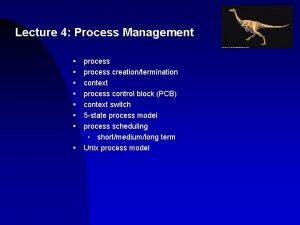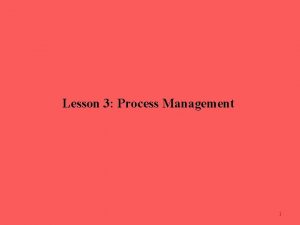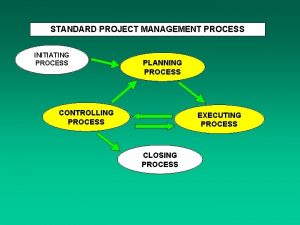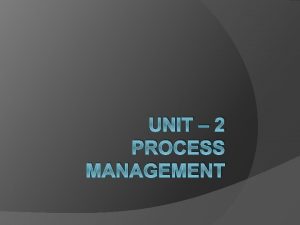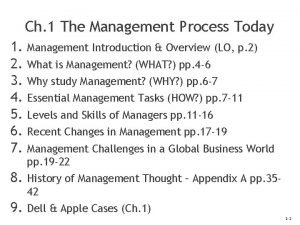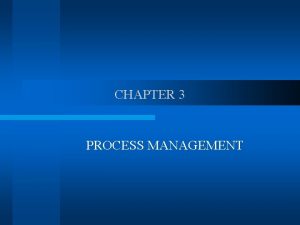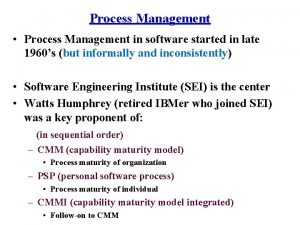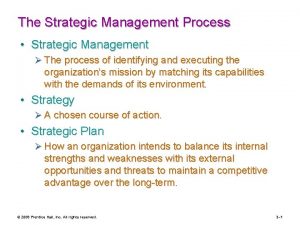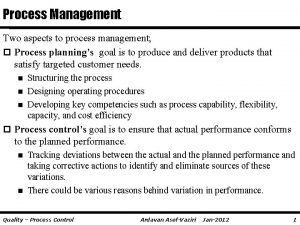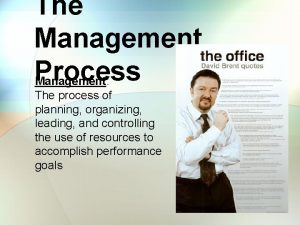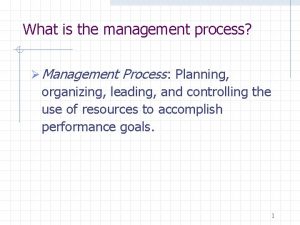Ch 1 The Management Process Today 1 Management


































- Slides: 34

Ch. 1 The Management Process Today 1. Management Introduction & Overview 2. What is Management? 3. Essential Management Tasks 4. Levels and Skills of Managers 5. Recent Changes in Management 6. Management Challenges in a Global Business World 1 -1

Learning Objectives • Describe what management is, why management is important, what managers do, and how managers use organizational resources efficiently and effectively to achieve organizational goals • Distinguish among planning, organizing, leading, and controlling (the four principal managerial tasks), and explain how managers’ ability to handle each one affects organizational performance

Learning Objectives • Differentiate among three levels of management, and understand the tasks and responsibilities of managers at different levels in the organizational hierarchy • Distinguish among three kinds of managerial skill, and explain why managers are divided into different departments

Learning Objectives • Discuss some major changes in management practices today that have occurred as a result of globalization and the use of advanced information technology (IT) • Discuss the principal challenges managers face in today’s increasingly competitive global environment

What is Management? • Management: The planning, organizing, leading, and controlling of human and other resources to achieve organizational goals effectively and efficiently • Organizations: Collections of people who work together and coordinate their actions to achieve a wide variety of goals

What is Management? • Managers • The people responsible for supervising the use of an organization’s resources to meet its goals • Resources include: • People, skills, know-how, experience; machinery, raw materials, computers and IT, patents, and financial capital, and loyal customers and employees

Achieving High Performance • Organizational performance: A measure of how efficiently and effectively managers use organizational resources to satisfy customers and achieve goals

Figure 1. 1 - Efficiency, Effectiveness, and Performance in an Organization

Organizational Performance Efficiency • A measure of how well or productively resources are used to achieve a goal Effectiveness • A measure of the appropriateness of the goals an organization is pursuing and the degree to which they are achieved

Why Study Management? • The more effective and efficient use an organization can make of resources, the greater the relative well-being of people • Managers have to understand other people at work, make decisions and take actions • Understanding management is one important path toward obtaining a satisfying career

Figure 1. 2 - Four Tasks of Management

Planning • Process of identifying and selecting appropriate goals and courses of action • Includes 3 steps, collectively called a “Strategy” • • Deciding which goals to pursue • Deciding how to allocate organizational resources Deciding what course of action to adopt to attain those goals

Organizing • Structuring working relationships so organizational members interact and cooperate to achieve organizational goals • Organizational structure: A formal system of task and reporting relationships that coordinates and motivates organizational members so that they work together to achieve organizational goals

Leading • Articulating a clear vision and energizing and enabling organizational members so they understand the part they play in attaining organizational goals • The outcome of leadership is a highly motivated and committed workforce

Controlling • Evaluating how well an organization is achieving its goals and taking action to maintain or improve performance • Outcome of the control process is the ability to measure performance accurately and regulate efficiency and effectiveness • Controlling helps managers evaluate how well they are performing the other 3 tasks of management— planning, organizing, and leading

Levels and Skills of Managers • Managers are grouped in : • Level or rank in the organization’s hierarchy • Based on their specific job-related skills, expertise, and experiences • Department: A group of people who work together and possess similar skills or use the same knowledge, tools, or techniques to perform their jobs

Question? What is a group of people who work together and possess similar skills or use the same knowledge, tools, or techniques? A. Organization B. Department C. Team D. Presentation group

Levels and Skills of Managers • First-line manager: Responsible for the daily supervision of nonmanagerial employees • Middle manager: Supervises first-line managers and is responsible for finding the best way to use resources to achieve organizational goals • Top manager: Establishes organizational goals, decides how departments should interact, and monitors the performance of middle managers

Top-Management Team • Group composed of the CEO, COO, and the heads of the most important departments • Play a crucial role in determining an organization’s long-term performance

Figure 1. 3 - Levels of Managers

Figure 1. 4 - Relative Amount of Time That Managers Spend on the Four Managerial Tasks

Figure 1. 5 - Types and Levels of Managers

Question? Which management skill is the ability to understand, alter, lead, and control the behavior of other individuals and groups? A. Conceptual B. Human C. Team D. Technological

Managerial Skills • Conceptual skills: Ability to analyze and diagnose a situation and distinguish between cause and effect • Human skills: Ability to understand, alter, lead, and control the behavior of other individuals and groups • Technical skills: The job-specific knowledge and techniques required to perform an organizational role • Core competency: Specific set of skills, abilities, and experiences that allows one organization to outperform its competitors

Question? What is the specific set of abilities that allows one manager to perform at a higher level than another manager? A. Skill-sets B. SKAs C. Competencies D. Skill traits

Recent Changes in Management Practices • Restructuring: Downsizing an organization by eliminating the jobs of large numbers of top, middle, and first-line managers and nonmanagerial employees • Modern IT has increased each person’s ability to process information and make decisions more quickly and accurately

Recent Changes in Management Practices • Outsourcing: Contracting with another company, usually abroad, to have it perform an activity the organization previously performed itself • Increases efficiency because it lowers operating costs, freeing up money and resources that can be used in more effective ways

Empowerment • The expansion of employees’ knowledge, tasks, and decision-making responsibilities • Companies use their reward systems to promote empowerment • IT is being increasingly used to empower employees because it expands employees’ job knowledge and increases the scope of their job responsibilities

Self-Managed Teams • A group of employees who assume responsibility for organizing, controlling, and supervising their own activities and monitoring the quality of the goods and services they provide • Assume many tasks and responsibilities previously performed by first-line managers, so a company can better utilize its workforce

Global Organizations • Organizations that operate and compete in more than one country

Challenges for Management in a Global Environment • Building a competitive advantage • The ability of one organization to outperform other organizations in producing goods or services more efficiently and effectively • Companies can win or lose the competitive race depending on their speed and flexibility • Innovation: Process of creating new or improved goods and services or developing better ways to produce or provide them

Challenges for Management in a Global Environment • Maintaining ethical standard • Pressure to increase performance can be healthy— it leads managers to question how the organization is working • Too much pressure to perform - induces managers to behave unethically

Challenges for Management in a Global Environment • Managing a diverse workforce • • Age, gender, race, ethnicity, religion, sexual preference, and socioeconomic composition of the workforce presents new challenges for managers Establish procedures and practices that are legal, fair, and equitable • Utilizing new information systems and technologies • Managers have to continually find efficient and effective ways to utilize new IT to better perform jobs

Challenges for Management in a Global Environment • Practicing global crisis management involves making important choices about how to: • Create teams to facilitate rapid decision making and communication • • • Establish the organizational chain of command Recruit and select the right people Develop bargaining and negotiating strategies to manage conflicts
 Today meeting or today's meeting
Today meeting or today's meeting Today's class answers
Today's class answers Today meeting or today's meeting
Today meeting or today's meeting Galton details
Galton details Today's lesson or today lesson
Today's lesson or today lesson Today's lesson or today lesson
Today's lesson or today lesson Hát kết hợp bộ gõ cơ thể
Hát kết hợp bộ gõ cơ thể Lp html
Lp html Bổ thể
Bổ thể Tỉ lệ cơ thể trẻ em
Tỉ lệ cơ thể trẻ em Voi kéo gỗ như thế nào
Voi kéo gỗ như thế nào Tư thế worms-breton
Tư thế worms-breton Chúa yêu trần thế
Chúa yêu trần thế Các môn thể thao bắt đầu bằng tiếng đua
Các môn thể thao bắt đầu bằng tiếng đua Thế nào là hệ số cao nhất
Thế nào là hệ số cao nhất Các châu lục và đại dương trên thế giới
Các châu lục và đại dương trên thế giới Cong thức tính động năng
Cong thức tính động năng Trời xanh đây là của chúng ta thể thơ
Trời xanh đây là của chúng ta thể thơ Cách giải mật thư tọa độ
Cách giải mật thư tọa độ Phép trừ bù
Phép trừ bù Phản ứng thế ankan
Phản ứng thế ankan Các châu lục và đại dương trên thế giới
Các châu lục và đại dương trên thế giới Thể thơ truyền thống
Thể thơ truyền thống Quá trình desamine hóa có thể tạo ra
Quá trình desamine hóa có thể tạo ra Một số thể thơ truyền thống
Một số thể thơ truyền thống Cái miệng bé xinh thế chỉ nói điều hay thôi
Cái miệng bé xinh thế chỉ nói điều hay thôi Vẽ hình chiếu vuông góc của vật thể sau
Vẽ hình chiếu vuông góc của vật thể sau Nguyên nhân của sự mỏi cơ sinh 8
Nguyên nhân của sự mỏi cơ sinh 8 đặc điểm cơ thể của người tối cổ
đặc điểm cơ thể của người tối cổ Ví dụ về giọng cùng tên
Ví dụ về giọng cùng tên Vẽ hình chiếu đứng bằng cạnh của vật thể
Vẽ hình chiếu đứng bằng cạnh của vật thể Phối cảnh
Phối cảnh Thẻ vin
Thẻ vin đại từ thay thế
đại từ thay thế điện thế nghỉ
điện thế nghỉ









































